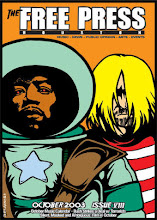Me and Orson Welles: Richard Linklater interview

When Richard Linklater purchased the rights to Robert Kaplow’s Me and Orson Welles, a fictionalized novel that takes place during the 1937 Mercury Theatre production Julius Caesar, he knew he might never make the film.
“Welles was the master of balancing genius and disaster, his whole life is about that. It’s extremely daunting; he’s the big director. It’s like a Christian making a film about Christ,” Linklater told Free Press Houston during an interview.
In recent films Welles has been played by Vincent D’Onofrio (Ed Wood, although Tim Burton dubbed the voice with another actor), Angus Macfadyen (Cradle Will Rock), and Liev Schrieber (RKO 281). Linklater wanted an actor that could fill the shoes of a young Welles, yet he didn’t want a known commodity. “Welles made masterpieces in four different decades. That’s a career,” remarked Linklater.
“Kaplow sent me an email saying to go check out this guy doing a one-man show about Welles at a 50-seat theater in New York. It’s a wonderful play, it starts at War of the Worlds and goes to the end of his life,” recalled Linklater.
That actor is Christian McKay and to see his performance in Me and Orson Welles is to see a star in the making. Linklater admits he wouldn’t have done the film if he hadn’t found McKay.
“The thing about Christian is that you don’t know him. With an unknown the critical antenna comes down. You are with Orson Welles hanging out at the Mercury Theater,” explained Linklater. “That’s the magic of cinema.”
McKay hails from Manchester in the UK. “His big influences are people like Richard Burton or Winston Churchill. He helped to create the one-man show mainly as motivation for when he was an out of work actor.”
Me and Orson Welles was shot in the UK, on the isle of Man for the interior of the Mercury Theatre, with exteriors and other sets shot at Pinewood Studios. In fact, expect to see some play from Me and Orson Welles at the 2010 BAFTA awards as it was primarily and English production.
“1937 New York is so long gone,” noted Linklater. “This theater on the Isle of Man had the correct stage area, the same size trap doors, a similar area under the stage. There’s one existing photo of the interior of the Mercury theater, and the orchestra and balcony are similar.”
The Isle of Man also had a film fund that Linklater was qualified to use due to shooting there. “They became my main producers. I know all about the Isle of Mann now, they have the longest standing government, over 1000 years. They’re a little jewel in the British crown; the Queen comes over ever 30 years,” laughed Linklater. The film credits include CinemaNX and Isle of Man Film. The manx cat also hails from the Isle of Man.
“Cecil Beaton took a series of ten photos so we have those as references,” said Linklater. “Some of the lighting design Welles had based on Triumph of the Will, he wanted it to look like a fascist rally.”
Me and Orson Welles depicts Welles as an immovable genius who used any means necessary to accomplish his goals and Linklater captures the atmosphere of that audacity. For instance, did Welles regularly take an ambulance from rehearsal to his CBS radio gig?
“Who knows with Welles,” queried Linklater. “Where does that myth meet reality? I would think with Welles he probably did that once but it’s the kind of movie where you print the legend.”
Me and Orson Welles opens Friday in an exclusive engagement at the Angelika.









0 Comments:
Post a Comment
<< Home